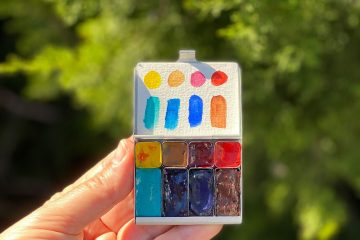When I first started painting I went on a quest for the perfect red — little did I know that I could mix red from magenta and yellow — and I knew nothing about pigment numbers.
Mixing Red
Yes, everything I learned in school was wrong — red is not a primary color since it can be mixed from magenta and yellow. When I first tried this my mind was blown! Try it yourself and watch the magic happen.

Pigment Numbers
Now let’s talk pigment numbers!
I purchased so many tubes of red paint to try before I learned about pigment numbers, and I unknowingly bought several tubes that were the same exact pigment — just called by a different name. Don’t let this happen to you! 🙂
A pigment number refers to the pigment powder that the paint is made from — see this article from Bruce at handprint.com for all the nitty gritty details. His site is such a good reference, can’t recommend it enough. The pigment number can be found on the side of the tube and now that I know better I pay attention to this way more than the marketing name of the paint.

Here are some swatches of PR209 and PR254 from different brands. They might handle a little differently since each manufacturer uses it’s own process to turn the pigment powder into paint, but they’re super close in color. If you’re on a mission to find your perfect red you owe it to yourself to check out the pigment numbers so you don’t get duplicates.

Convenience Reds
So since we can mix red, why do we need red paints on our palette? Much like premixed greens, they’re super handy to have and really come in handy for florals and special projects.
Here are a few from my stash that I gathered for a Valentine’s Day project:

Here’s a bit about each one:
PV19
- Daniel Smith quinacridone rose, Winsor & Newton permanent rose, DaVinci permanent rose quinacridone
- PV19 is a cool toned pink that can mix with yellow to form red. Note that PV19 has a wide range of hues depending on how it’s treated, and it’s a color that does have a little more variation between brands.
- This one is a staple on my palette, I use it for my magenta.
PR122
- Winsor & Newton quinacridone magenta. I don’t think Daniel Smith has paint made from this pigment in their line. Their Quin Magenta is PR202 and looks to be a much darker purple.
- PR122 is a true magenta — I always wondered how it compared to PV19 and had to try it! It mixes lovely purples with any blue. I don’t keep this one in my palette since I find quin rose more useful and they’re so similar.
Permanent Alizarin Crimson
- This is the first swatch in the sample that isn’t a single pigment paint. This Daniel Smith version is made of PR177, PV19 and PR149, check other brands for their composition. Note that if the paint tube doesn’t say “permanent” it may be made from PR83, which is the original version — and it’s not lightfast.
- This red is really reactive wet-on-wet and you can get some really cool effects with it!
- I usually put it on my palette in fall/winter.
PR209
- Daniel Smith quinacridone coral, Winsor & Newton and DaVinci both call this quinacridone red.
- This is the color that really got me looking at pigment numbers — I have a tube of it from each brand doh!
- I sometimes put this on my palette in spring for painting wildflowers. It’s also gorgeous for sunset skies.
- The main reason it’s not on my palette is because it’s not a very strong mixer.
PR254
- Daniel Smith Pyrrol Scarlet, Winsor & Newton Winsor Red
- It’s a really beautiful red but I don’t like how much it loses saturation as it dries so it’s another one that’s not on my palette. It’s also reactive wet on wet, although not as much as permanent alizarin crimson.
PR188
- Daniel Smith organic vermilion, Winsor & Newton scarlet lake
- I started using this one instead of cadmium scarlet — love that it’s semi-transparent, but lightens to a lovely light orange.
- I’ve had it on my palette for a few months now and am really liking it! It also makes a beautiful red mixed with quin rose.
Holbein Shell Pink
- I have this one on my desert palette and I always get so many questions about it so I thought I’d include it here.
- It’s made from P073 (pyrrol orange!) and PW6 (titanium white)

Further Reading

So there you have it. Which reds are in your palette? I’d love to hear!



1 Comment
wine-is com · May 9, 2022 at 7:32 am
Good post. I’m dealing with a few of these issues as well..